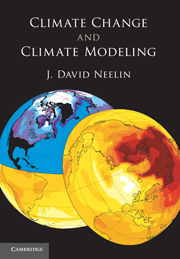Book contents
- Frontmatter
- Contents
- Preface
- 1 Overview of climate variability and climate science
- 2 Basics of global climate
- 3 Physical processes in the climate system
- 4 El Niño and year-to-year climate prediction
- 5 Climate models
- 6 The greenhouse effect and climate feedbacks
- 7 Climate model scenarios for global warming
- Glossary
- References
- Index
1 - Overview of climate variability and climate science
Published online by Cambridge University Press: 05 June 2012
- Frontmatter
- Contents
- Preface
- 1 Overview of climate variability and climate science
- 2 Basics of global climate
- 3 Physical processes in the climate system
- 4 El Niño and year-to-year climate prediction
- 5 Climate models
- 6 The greenhouse effect and climate feedbacks
- 7 Climate model scenarios for global warming
- Glossary
- References
- Index
Summary
Climate dynamics, climate change and climate prediction
Climate is commonly thought of as the average condition of the atmosphere, ocean, land surfaces and the ecosystems that dwell in them. Every one knows what is meant by “Baja California has a desert climate” in terms of average temperature, average rainfall, average moisture in the air, and vegetation. Climate also includes the average wind direction and strength, average cloud cover, the temperature of the sea surface nearby, which affects the previous quantities, and the ocean currents that affect the sea surface temperature, and so on. While we might care most about the local climate in the land regions where we live, this interconnectedness of the climate system implies that we have to study it globally.
In contrast to climate, weather is the state of the atmosphere and ocean at a given moment in time. As the saying goes, “climate is what you expect, weather is what you get.” However, climate includes not only average quantities, such as average precipitation, but also average measures of weather-related variability. These would include, for instance, the probability of a major rainfall event occurring in July in Baja, the range of variations of temperature that typically occur during January in Chicago, or the number of hurricanes that typically hit the US coast per year. Climate may thus be considered to include all quantities defined by averaging over the weather, i.e. over time scales of many weather events.
- Type
- Chapter
- Information
- Climate Change and Climate Modeling , pp. 1 - 33Publisher: Cambridge University PressPrint publication year: 2010



